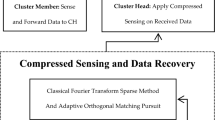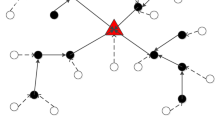Abstract
Recently it has been shown that when Principal Component Analysis is applied as a dictionary learning technique to Compressive Sensing-based data aggregation, using a Deterministic Node Selection method for data collection in Wireless Sensor Networks can outperform Random Node Selection ones. In this paper, a new scheduling method for selection of measured nodes in a data collection round, called “Information-Based Deterministic Node Selection”, is proposed. Simulation results for synthetic and real data sets show that the proposed method outperforms a reference DNS method in terms of energy consumption per reconstruction error. Correlation (or covariance) matrix estimation is necessary for DNS strategies which are accomplished by gathering data from all network nodes in a few initial time slots of collection rounds. In this regard, we also propose the use of a particular type of shrinkage estimator in preference to the standard correlation matrix estimator. With the aid of the new estimator, we can obtain data correlations with the same accuracy of standard estimator while we need less number of observations. Our numerical experiments demonstrate that when the number of measured nodes is less than 50% of the total nodes, using shrinkage estimator causes extra energy savings in sensor nodes.









Similar content being viewed by others
Notes
If actual data of nodes are available in any previous time slot we utilize these values instead of reconstructed data.
The value of H should not be great for any non-stationary signal. As shown in reference [18], the best results are obtained for the real signals by selecting the number 2 for H.
Refer to Appendix A in reference [22] for detailed information on how to calculate the quantity \(\mathop {Var}\limits ^{\wedge } (s_{ij} ) \)
References
Ebrahimi, Dariush, & Assi, Chadi. (2014). Compressive data gathering using random projection for energy efficient wireless sensor networks. Ad Hoc Networks, 16, 105–119.
Huang, J., & Soong, B. (2019). Cost-aware stochastic compressive data gathering for wireless sensor networks. IEEE Transactions on Vehicular Technology, 68(2), 1525–1533.
Kingsy Grace, R., & Manju, S. (2019). A comprehensive review of wireless sensor networks based air pollution monitoring systems. Wireless Personal Communications, 108(4), 2499–2515.
Ma, Yuan, Zhang, Xingjian, & Gao, Yue. (2017). Joint sub-nyquist spectrum sensing scheme with geolocation database over TV white space. IEEE Transactions on Vehicular Technology, 67(5), 3998–4007.
Zhang, X., Ma, Y., Gao, Y., & Zhang, W. (2018). Autonomous compressive-sensing-augmented spectrum sensing. IEEE Transactions on Vehicular Technology, 67(8), 6970–6980.
Lustig, Michael, Donoho, David L., Santos, Juan M., & Pauly, John M. (2008). Compressed sensing MRI. IEEE Signal Processing Magazine, 25(2), 72–82.
Candes, Emmanuel J., Romberg, Justin, & Tao, Terence. (2006). Robust uncertainty principles: exact signal reconstruction from highly incomplete frequency information. IEEE Transactions on Information Theory, 52(2), 489–509.
Baraniuk, Richard, Davenport, Mark, DeVore, Ronald, & Wakin, Michael. (2008). A simple proof of the restricted isometry property for random matrices. Constructive Approximation, 28(3), 253–263.
Bajwa, W. U., Haupt, J. D., Sayeed, A. M., & Nowak, R. D. (2007). Joint source-channel communication for distributed estimation in sensor networks. IEEE Transactions on Information Theory, 53(10), 3629–3653.
Haupt, Jarvis, Bajwa, Waheed U., Rabbat, Michael, & Nowak, Robert. (2008). Compressed sensing for networked data. IEEE Signal Processing Magazine, 25(2), 92–101.
Godwin Shen, So Yeon Lee, Sungwon Lee, Sundeep Pattem, Aaron Tu, Bhaskar Krishnamachari, Antonio Ortega, Michael Cheng, Sam Dolinar, & Aaron Kiely.(2008). Novel distributed wavelet transforms and routing algorithms for efficient data gathering in sensor webs. In NASA Earth Science Technology Conference (ESTC),
Chong Luo, Feng Wu, Jun Sun, & Chang Wen Chen.(2009). Compressive data gathering for large-scale wireless sensor networks. In Proceedings of the 15th annual international conference on Mobile computing and networking, pages 145–156. ACM,
Liu Xiang, Jun Luo, & Athanasios Vasilakos.(2011). Compressed data aggregation for energy efficient wireless sensor networks. In 8th annual IEEE communications society conference on Sensor, mesh and ad hoc communications and networks (SECON), pages 46–54
Sungwon Lee, Sundeep Pattem, Maheswaran Sathiamoorthy, Bhaskar Krishnamachari, & Antonio Ortega.(2009) Compressed sensing and routing in multi-hop networks. Technical report, University of Southern California
Giorgio Quer, Riccardo Masiero, Daniele Munaretto, Michele Rossi, Joerg Widmer, & Michele Zorzi. (2009).On the interplay between routing and signal representation for compressive sensing in wireless sensor networks. In Information Theory and Applications Workshop, pages 206–215. IEEE
Wei Wang, Minos Garofalakis, & Kannan Ramchandran.(2007). Distributed sparse random projections for refinable approximation. In Proceedings of the 6th international conference on Information processing in sensor networks (IPSN), pages 331–339. ACM
Rana, Rajib, Wen, Hu., & Chou, Chun Tung. (2010). Energy-aware sparse approximation technique (EAST) for rechargeable wireless sensor networks. European conference on wireless sensor networks (pp. 306–321). NewYork: Springer.
Quer, Giorgio, Masiero, Riccardo, Pillonetto, Gianluigi, Rossi, Michele, & Zorzi, Michele. (2012). Sensing, compression, and recovery for WSNs: Sparse signal modeling and monitoring framework. IEEE Transactions on Wireless Communications, 11(10), 3447–3461.
Hooshmand, M., Rossi, M., Zordan, D., & Zorzi, M. (2016). Covariogram-based compressive sensing for environmental wireless sensor networks. IEEE Sensors Journal, 16(6), 1716–1729.
Stein, Charles. (1956). Inadmissibility of the usual estimator for the mean of a multivariate normal distribution. in proc. of the 3rd berkeley symp. on math. Statist. Prob., 1, 197–206.
James, W., & Stein, C. (1961). Estimation with quadratic loss. In Proc. of 4th Berkeley Symp. on Math. Statist. Prob., 1, 361–380.
Juliane Schäfer & Korbinian Strimmer.(2005). A shrinkage approach to large-scale covariance matrix estimation and implications for functional genomics. Statistical applications in genetics and molecular biology, 4(1):
Rainer Opgen-Rhein & Korbinian Strimmer.(2007). Accurate ranking of differentially expressed genes by a distribution-free shrinkage approach. Statistical applications in genetics and molecular biology, 6(1):–,
Bell, Peter, & King, Simon. (2009). Diagonal priors for full covariance speech recognition. IEEE Workshop on Automatic Speech Recognition and Understanding (ASRU), 113–117.
Leonardo R Bachega, James Theiler, and Charles A Bouman. Evaluating and improving local hyperspectral anomaly detectors. In IEEE Applied Imagery Pattern Recognition Workshop (AIPR), pages 1–8, 2011.
Chen, Yilun, Wiesel, Ami, Eldar, Yonina C., & Hero, Alfred O. (2010). Shrinkage algorithms for MMSE covariance estimation. IEEE Transactions on Signal Processing, 58(10), 5016–5029.
Lancewicki, Tomer, & Aladjem, Mayer. (2014). Multi-target shrinkage estimation for covariance matrices. IEEE Transactions on Signal Processing, 62(24), 6380–6390.
Moteiv Corporation. Tmote sky datasheet, 2006.
Texas Instruments. Msp430x1xx family user’s guide, 2006.
Texas Instruments. cc2420 datasheet, 2007.
Liang, Yao, & Peng, Wei. (2010). Minimizing energy consumptions in wireless sensor networks via two-modal transmission. ACM SIGCOMM Computer Communication Review, 40(1), 12–18.
Mohimani, Hosein, Babaie-Zadeh, Massoud, & Jutten, Christian. (2009). A fast approach for overcomplete sparse decomposition based on smoothed l0 norm. IEEE Transactions on Signal Processing, 57(1), 289–301.
Jolliffe, Ian. (2011). Principal component analysis. NewYork: Springer.
Michele Rossi, Mohsen Hooshmand, Davide Zordan, & Michele Zorzi.(2015) Evaluating the gap between compressive sensing and distributed source coding in WSN. In International Conference on Computing, Networking and Communications (ICNC), pages 911–917. IEEE
Davide Zordan, Giorgio Quer, Michele Zorzi, & Michele Rossi.(2011) Modeling and generation of space-time correlated signals for sensor network fields. In Global Telecommunications Conference (GLOBECOM), pages 1–6. IEEE
Vuran, Mehmet C., & Akyildiz, Ian F. (2006). Spatial correlation-based collaborative medium access control in wireless sensor networks. IEEE/ACM Transactions On Networking, 14(2), 316–329.
R. Cristescu & M. Vetterli.(2005). On the optimal density for real-time data gathering of spatio-temporal processes in sensor networks. In 4th International Symposium on Information Processing in Sensor Networks (IPSN), pages 159–164
Amol Deshpande, Carlos Guestrin, Samuel R Madden, Joseph M Hellerstein, & Wei Hong. (2004) Model-driven data acquisition in sensor networks. In Proc. of the 30th international conference on Very large Data Bases, volume 30, pages 588–599
Cover, Thomas M., & Thomas, Joy A. (2012). Elements of information theory. NewYork: Wiley.
Author information
Authors and Affiliations
Corresponding author
Additional information
Publisher's Note
Springer Nature remains neutral with regard to jurisdictional claims in published maps and institutional affiliations.
Rights and permissions
About this article
Cite this article
Imanian, G., Pourmina, M.A. & Salahi, A. Information-Based Node Selection for Joint PCA and Compressive Sensing-Based Data Aggregation . Wireless Pers Commun 118, 1635–1654 (2021). https://doi.org/10.1007/s11277-021-08108-9
Accepted:
Published:
Issue Date:
DOI: https://doi.org/10.1007/s11277-021-08108-9




